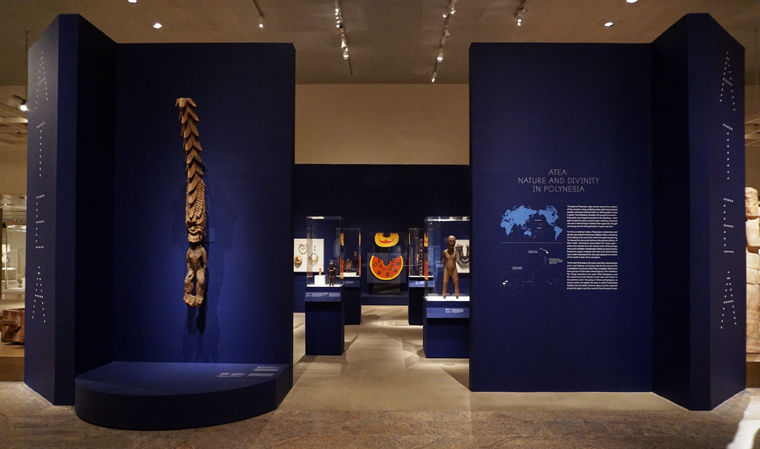
Throughout Polynesia, origin stories recount the creation of the universe: a long, endlessly deep night that pulsated steadily until space hollowed itself out, allowing light to seep in (atea). This exhibition considers the powerful moment—Polynesia's cosmological equivalent to the Big Bang—when light flooded the dark ancestral night, initiating a dynamic new era in which strings of islands were vigorously brought into being and the first generation of gods was born.
Far from an abstract notion, Polynesians' relationship with divinity was rooted in the bones, feathers, fibers, and plants of the islands and ocean from which the gods had sprung. To channel the divine and enhance the spiritual efficacy of their chiefs—themselves descended from these gods—artists drew directly from the natural world. While prestige items such as feather headdresses reinforced spiritual status (mana), the organic materials with which such ritual artifacts were made emphasized the close genealogical connection of the chiefs to their divine ancestors.
To the early Polynesians, the ocean was both a sacred space and a vast highway connecting islands that mirrored the constellations of stars by which they navigated. Works from three groups of Polynesian islands figure in this exhibition: Fiji, Tonga, and Niue in the west; Tahiti, Mangareva, and the Austral and Cook Islands to their east; and Hawai'i in the extreme north. Focusing on these archipelagoes as anchor points, we explore the ways in which Polynesians distilled core principles of divine agency as they migrated across the region over the course of two thousand years.

The ancestral homeland, or dwelling place of the gods, was a potent site that figured in many islander traditions as a dark underworld. In Tonga, this watery realm was known as Pulotu. Associated with the night and with things invisible and unknown, Pulotu was accessible via portals found in deep pools and hidden cave interiors. As the dwelling place of ancestral spirits, it was also deemed an important point of origin and a source for spiritually "hot" or charged (tapu) natural materials.
Islanders privileged certain species of plants, birds, and marine life—those understood to have originated in the ancestral realm—as capable of creating the dynamic connections necessary to communicate with the gods. The incorporation of coconut cord fiber, whale ivory, and the wood of the sacred vesi tree into complex woven works and figural sculpture activated Polynesians' relationship with the ancestors and drew divine potency into the immediate present. Whales in particular were deemed to be embodiments of the first creator god, Tangaloa, who presided over the sacred realm of the ocean. Shaped and polished into spectacular breastplates or carved into female figurines housed in portable shrines, whale ivory was not only the rarest of commodities, it was also a sacred relic that served as an ideal conduit for the gods.

Polynesians imagine the expansive, crescent-shaped canopy of the sky as tethered at each corner and receding into a series of bounded spheres. The last of these layers is known in Tahiti as te ra'i ha'amāma, a name that suggests a gaping or yawning opening that unfolds into perpetual darkness. This final sky canopy, the most remote in distance and time from the earthly domain of humans, blends into the ancestral realm inhabited by the principal Polynesian gods. Human existence plays out in a fragile sphere of light beneath this vast dome. In a compelling representation of the universe on display in this exhibition, the nineteenth-century Tuamotuan chief Paiore shows human figures emerging from an abundance of marine and plant life. With arms raised, successive generations of leaders prop up each sphere of the sky to keep the potentially engulfing darkness at bay.
The most extensive ritual precinct in central Polynesia was Tapu-tapu-atea, meaning vast and sacred light. Located on the island of Ra'iatea, it was said to be the birthplace of the gods. Its monumental stone temples—the "jawbones" of the gods—were the focus of ritual encounter. Crescent-shaped ceremonial headdresses were designed to formally evoke the vaulted dome of the sky. By contrast, upright wooden staff gods called to'o (meaning baton or post) represent the vertical plane connecting land and sky. Animated in ritual, these ceremonial staffs functioned as live channels linking the human and godly realms.

Gods, chiefs, and the natural world were closely linked in Polynesia and especially in Hawai'i, where genealogy was paramount. A high-ranking chief was not simply an agent of the gods but their earthly counterpart. Armed with whale ivory and shark teeth and enveloped in dramatic feathered capes and helmets, the elite class of Hawai'ian chiefs (ali'i) staked claim to legitimate leadership. By marshaling the forces of the natural world in visually dynamic ways, they enhanced their own spiritual efficacy.
These chiefs were also understood to be divine embodiments of the vitality associated with agricultural prosperity. Since ancestral deities ensured growth and life, it was essential for leaders to maintain productive relationships with their gods, and they renewed these connections periodically with appropriate rites. Growing seasons were governed by the stars and in particular the cyclical rise and fall of the constellation Pleiades. The appearance every November of these seven stars (Makali'i, literally "eyes of the gods") on the horizon signaled the beginning of Makahiki, a festival which celebrated the god Lono and the coming of the rains. Their visibility was an auspicious sign that the ancestral gods were present, anticipating an abundant and prosperous season.
Ritual dish (Daveniyaqona), early 19th century. Fiji. Wood, 12 3/4 x 7 3/4 x 2 in. (32.4 x 19.7 x 5.1 cm). The Metropolitan Museum of Art, New York, Purchase, 2017 Benefit Fund, Gordon Sze, MD, The Richman Family Foundation, and Steven Kossak Gifts, Andrea Bollt Bequest, in memory of Robert Bollt Sr. and Robert Bollt Jr., and Ruddock Foundation for the Arts Gift, 2018 (2018.433)